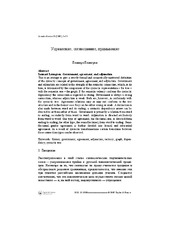Blar i forfatter Artikler, rapporter og annet (språk og kultur) "Lönngren, Lennart"
-
Knig pjat' vs Knig - pjat': A valency analysis
Lönngren, Lennart (Journal article; Tidsskriftartikkel, 2005)This study is an attempt to perform a valency analysis of two Russian constructions which differ only on the suprasegmental level: the noun phrase knig pjat' (‘approximately five books’) and the sentence Knig – pjat' (‘As to books, there are five of them’). In the semantic representation of the NP the additional meaning indicated in the translation is accounted for by the introduction of a ... -
Means of expressing similarity in Russian
Lönngren, Lennart (Journal article; Tidsskriftartikkel, 2003) -
Mnogoaktantnye predlogi v russkom jazyke
Lönngren, Lennart (Journal article; Tidsskriftartikkel, 2006) -
O pervom aktante russkogo predloga
Lönngren, Lennart (Journal article; Tidsskriftartikkel, 2007) -
On the interrelations between "Parts of Speech" and "Cases" in Russian
Lönngren, Lennart (Journal article; Tidsskriftartikkel, 2002)The seemingly simple relations between these two categories turn out to be quite complex in the framework of a dependency grammar in which all kinds of segmental linguistic signs are involved: not only free, explicit words but also morphologically incorporated lexemes and implicit lexemes. To the set of traditional cases are added CAS (general case), AGR (agreement case), PRP (prepositional phrase), ... -
On the witty preposition s
Lönngren, Lennart (Journal article; Tidsskriftartikkel, 2004)The Russian preposition s (with the instrumental case) exhibits an ambiguity which makes it apt for being used in puns and anecdotes. In certain contexts it oscillates between a more semantic function (comitative meaning in a broad sense) and a more syntactic. In the latter case it forms a preposition phrase which fills an actant position of another predicate. -
Upravlenie, soglasovanie, primykanie = Government, agreement, and adjunction
Lönngren, Lennart (Journal article; Tidsskriftartikkel; Peer reviewed, 2007)This is an attempt to give a strictly formal and semantically motivated definition of the syntactic concepts of government, agreement, and adjunction. Government and adjunction are related to the strength of the syntactic connection, which, in its turn, is determined by the comparison of the syntactic representation – the tree – with the semantic one – the graph. If the semantic valency confirms ...


 English
English norsk
norsk





